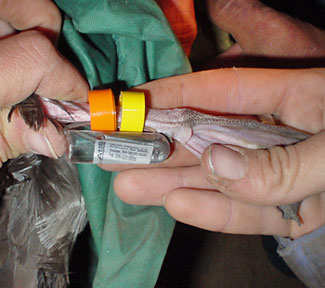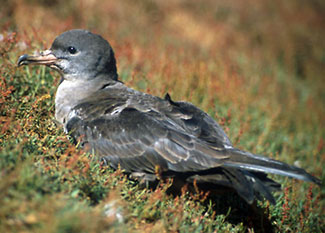Species of Concern Profile: Pink-footed Shearwater
September 2003
Oregon COASSTers found two Pink-footed Shearwaters on their beaches during September and October this year. Like other shearwater species and the Black-footed Albatross, Pink-foots migrate to the Pacific Northwest from distant locations. During the southern hemisphere (or austral) summer, Pink-foots return to only three known breeding islands, all in Chilean waters. In the non-breeding season, these birds migrate up the coast of the Americas, some as far north as the Gulf of Michelle Wainstein Peter Hodum Alaska. The beached individuals may very well have been on their way back to Chile to find their mates and raise a chick.
At-sea surveys show that Pink-foots tend to migrate farther offshore than other shearwaters, such as the Short-tailed or more common Sooty. This difference in behavior may be the reason we rarely see Pink-foots on COASST surveys. From offshore locations, Pink-foot carcasses would tend to drift for longer times and distances, trapped in longshore currents, preventing coastal deposition. However, the rarity of Pink-foots on our beaches may also be due to the fact that this species is significantly less abundant worldwide (estimated population <50,000 individuals) than Sooty and Short-tailed Shearwaters.
Teasing apart these relationships is of particular interest to another conservation organization based at the University of Washington, the Juan Fernández Islands Conservancy (JFIC). Biologists from the Conservancy study Pink-foots on two of the three islands where they breed, Santa Clara and Robinson Crusoe in the Juan Fernández Archipelago. JFIC monitors native seabird populations and breeding behavior, works to minimize the effects of introduced cats and rats on threatened seabird populations, and is involved in environmental education in the island communities.

A close-up of the geolocation tag. (Michelle Wainstein)
One of the Conservancy’s newest research projects includes deploying small instruments called geolocation tags on individual shearwaters to track their migratory voyages. These five-gram tags (top right photo) record location, temperature and pressure, allowing biologists to piece together the large and fine-scale patterns of Pink-foot migratory behavior. What migratory routes do the birds use? How much time do they spend flying, sitting on the water, or diving beneath the surface?

A Pink-footed Shearwater on the colony. (Peter Hodum)
How deep beneath the surface are they fishing? Though we certainly hope not, you may just encounter a tagged Pink-footed Shearwater on your beach someday. More importantly, combined with JFIC’s research effort, COASST data tracking mortality off the U.S. West Coast can help generate a complete picture of the natural history and biology of this vulnerable species.